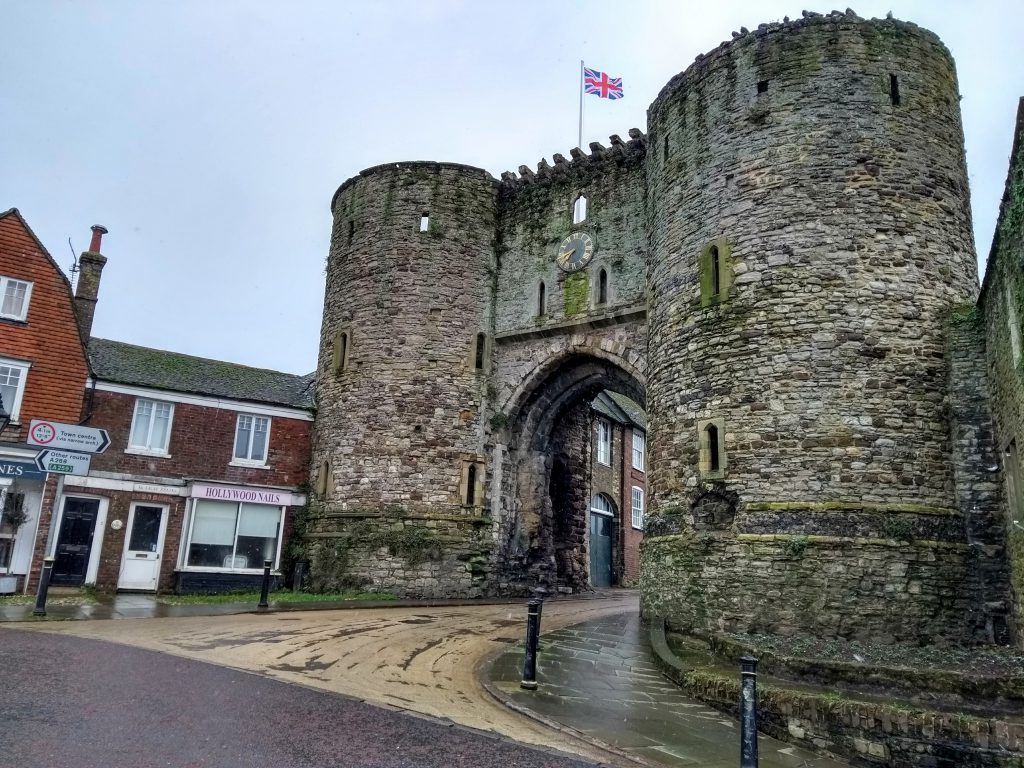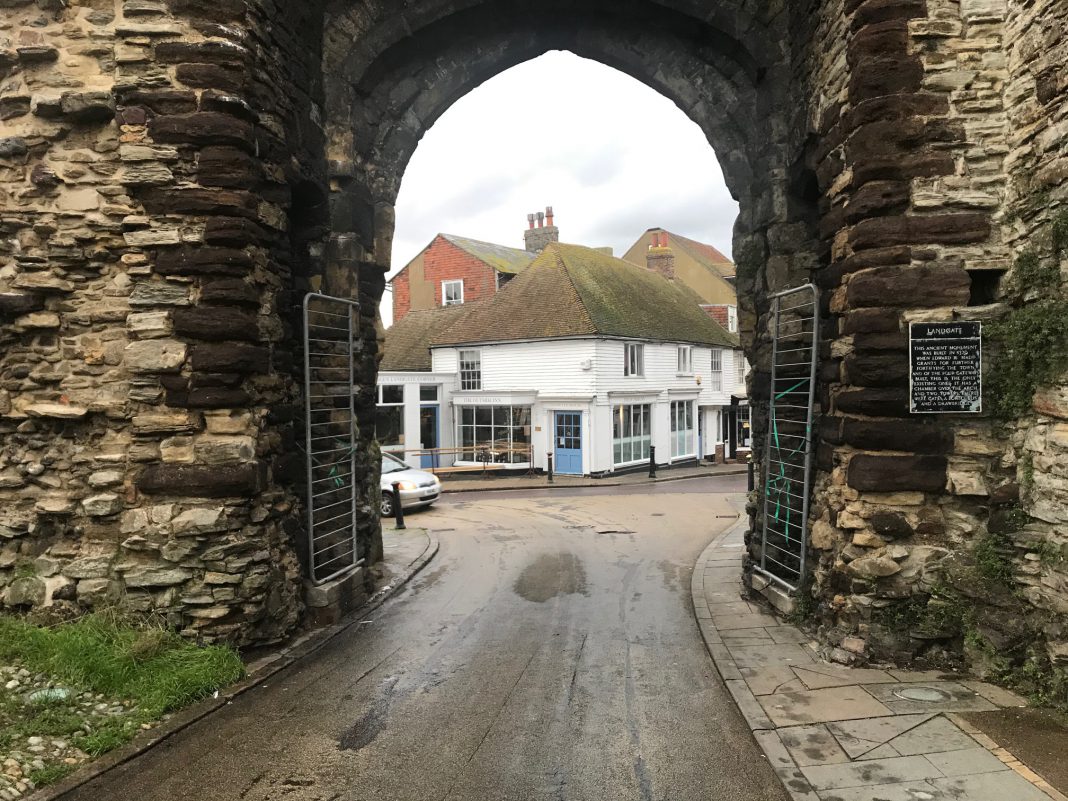There will be Ryers ( and non-Ryers), with better knowledge of Landgate than I have. I first saw it as a small child in the 1950s, when visiting my grandparents, but have only started researching its structure since moving to Rye in 2015.
Gillian Roder, Heidi Foster and others highlighted the need for action to address the state of Landgate in 2017 and that prompted my interest and research. I am hoping that writing this for Rye News might draw information from people with knowledge, photos and/or “evidence” about works that have been carried out in the past 130 years.
The focus of my research has been the north front of Landgate. It is the iconic face that welcomes everyone to the town. It was the face that could be defended against foes in the past. Its features are, or were, those used in fortifications in medieval times.
If attacked, a portcullis could be lowered. Archers could pick-off attackers from the relative safety of loopholes, arrow-slits, in the towers and objects or hot liquid, could be dropped through openings (machicolations) above the entrance, from behind the protection of a parapet wall.
Monument listed in 1951
The grade 1 listed ancient monument is described in its listing (October 1951) and I have found pictures and photographs online. The images provide evidence in terms of the structure and its condition through time.
In chronological order, I found the following images useful:
1831 An engraving – link
Late C19 A watercolour – link
1890 A photograph Photo of Rye, Landgate 1890 – link
Early C20 A two-horse coach being driven down King Street, Landgate: link
1925 Photograph – link
1950 Photograph – link
1955 Photograph – link
1960’s A photograph from Rye’s Own: link
1990 Photograph – link
Images are not shown here, as copyright might apply but can be viewed online – click on the links.
This recent photograph is provided for comparison:

Review of the images reveals that the parapet wall above the machicolations was lost about 120 years ago and that the stone string course (lintels that supported the parapet wall) was lost some time between 1960 and 1990.
The photograph from 1890 shows that the stonework was in very poor condition. There was a significant area of facing missing from the plinth of the east tower. It appears that the stonework was repaired soon after and certainly before 1925. The ashlar dressed stone surrounding openings and the dressed stone corbel immediately above the main arch were renewed at some time between the mid 1950s and 1960s.
Loss of the stone string course in more recent times means that, by definition, the machicolations have been lost. That’s rather sad because it is no longer obvious what the corbels were for and how this entrance into Rye could be defended.
Clock added in 1864
The watercolour by Louise Ingram Reyner from the late C19 shows the clock, which was added in 1864, click on this website
So, the evidence indicates that significant stonework repairs were carried out at the end of the C19 or early in the C20. Maybe Ryers won’t quite remember this?
Significant repairs were also carried out between 1955 and about the mid 1960s and that’s within living memory. Also, the string course that supported the parapet wall above the machicolations was removed at some time between the 1960s and 1990. Someone must remember that.
Are there council records? Surely such work must have been discussed and funded? I searched “The Keep” (ESCC records office) website. It lists photos, but nothing jumped out as offering more detailed information. Was the string course removed prior to or after local government reorganisation?
Hunting for listed building consent
I have searched the Rother planning records for listed building consent, which was surely required for any work after 1951. Nothing obvious jumped out of the plethora of applications. (There are lots of listed buildings in the Landgate area, or with Landgate in the title).
This is about as far as I have got in respect of the structure and its condition. It is helpful to look back and get a measure of how the structure has performed in the past, before looking forwards, to plan how to conserve the structure in the future.
Landgate today looks good for its 600+ years exposure to the elements. However, in 1890 Landgate looked all of its 500+ years age. Had significant repairs not been done in the last century, even more of the structure would have been lost.
[Editor’s note: The maintenance and possible use of the Landgate has been under discussion for some time (and indeed was on Rye Town Council’s agenda for this Monday’s meeting) with the oft voiced view that Rother District Council has done too little, too late. Let’s hope this inquiry into the Landgate’s past history may lead to a more permanent solution than the current situation which seems to leave this historic building open to further decay.]
Image Credits: Rye News Library , Geoffrey Austen .




Hello,
I have no knowledge of the history of The Landgate. However I am constantly in awe of it as the ‘portal’ and the ‘guardian’ of Rye.
I seem to remember that there was a group intending to Look After it. I would like to join this group. Thanks
It would be nice if there was a way to enforce shopfront signage that blends in with historical structures and locations. Is it appropriate for a Grade I listed structure to be next to a large sign for HOLLYWOOD NAILS ?
As for signage, I have memories of its suitability being very severely enforced in past years when anyone “tried it on” on High Street shop signage. As with many other things, nobody seems to do anything anymore, so it’s great that some people still care.
I certainly care a lot. I sometimes wonder if people have complete indifference to the way Rye looks. The Landgate is the entrance to our small town, do we not want it to look its best ? On the other side of The Landgate is Koops which does a roaring trade, in and out of lockdown. Koops is of course a modern drinks shop, but it blends in with its surroundings. However, it does have large sandwich boards outside which are unnecessary, and which force those in the queue for hot drinks to stand on the pavement which obstructs people who need to walk on it. Further up is Layla Mezze Grill and The Devil in Rye who both are using sandwich boards and those horrible large flapping flags which take up narrow pavement space. Already people need to walk in the road because our pavements are narrow, but should they be forced into the road because of street signage .. and how are disabled people and pensioners supposed to stay safely on the pavement ? Did the rot set in when there was a Woolworths who were criminally allowed to rip out the old windows and insert large bland panes of glass? The library which now occupies the space should have the original shopfront returned to how it should be. I respect that this topic started off about The Landgate. But the bigger picture is about preserving Rye, keeping it as authentic and unique as possible, and the place thousands of people from all over the world come to admire. It’s time to start pestering the Rye Conservation Society.
Andrew, I totally agree.
Can anyone remember work being carried out in the second half of the last century? The evidence is that significant work was carried out and any memories or photos would be very helpful.